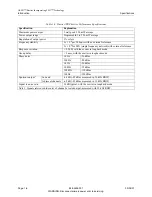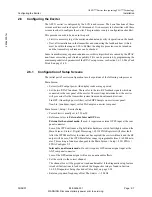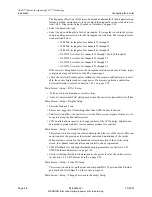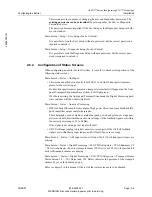
APEX
™
Exciter Incorporating FLO
™
Technology
Introduction
Installation
26
04s20
0.fm
03/08/07
888-2604-001
Page: 2-1
WARNING: Disconnect primary power prior to servicing.
2
Installation
2.1
Introduction
Exciters sold as part of a transmitter will normally have been tested in the transmitter
before shipment. The exciter may be removed for shipment, to be reinstalled after the trans-
mitter is in place. Installation is a simple process, as described in 2.2 below.
Exciters sold for retrofit into existing transmitter systems will not only require mounting
and appropriate mounting hardware, but because this exciter requires two RF samples,
additional sample cables may have to be installed.
Exciters sold for use in test facilities can either be rack mounted or operated standing on a
work surface.
2.2
Installing Exciters Removed for Shipment
If an exciter has been removed for shipment, the physical mounting hardware and
connecting harness should already be in place in the transmitter. Mount the exciter in its
mounting slides, fasten the flexible cable retractor (if used) to the rear and connect the
cables to the rear panel as marked.
The exciter should have been set up at the factory, and the settings recorded in the trans-
mitter final test data. The information in Section 3, Navigating the LCD Display Screens
and Section 2.6, Configuring the Exciter should be carefully studied before attempting to
operate the exciter or check the exciter setup against the factory final test data.
2.3
Signal Connections
Most of the input and output connections are at the rear of the exciter, only the RS232
connections are available at the front and rear. Figure 2-1 shows the rear panel connections.
• ASI #1 and ASI #2 are the (Isolated BNC) input connections for the low and high pri-
ority ASI transport streams. For best common mode rejection, this cable shield should
be grounded only at the source end.
The input impedance for each connector is 75 ohms. Belden 8281 or similar
high-quality video cable can be used to deliver this signal to the exciter over a dis-
tance of up to 1000 feet.
• ASI OUT is a sample output of the active transport stream.
• ANT (GPS antenna input) is an active input with +5V on the center conductor. Signal
frequency is 1575.42 MHz, level can range from -133 to -115 dBm, input impedance
is 50 ohms.
• 10MHZ REF IN (BNC) is the (Optional) 10 MHz reference frequency input. It is
used when precise control of the exciter’s frequency is required. Normal signal input
range is 0 to +10 dBm. The input impedance is 50 ohms.
• 1PPS (1 pulse per second input from the GPS receiver) is used with the 10MHz input
to time the super frames.
• HPF RF SAMPLE IN (SMA) is the input signal connector for an RF sample from
output of high power mask filter. It is used by RTAC™ (Real Time Adaptive Correc-
tion) to correct for the linear distortions of the high power filter. Normal input signal
range is -30 dBm to 0 dBm. The input impedance is 50 ohms.






























